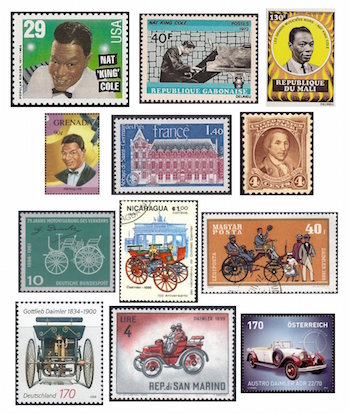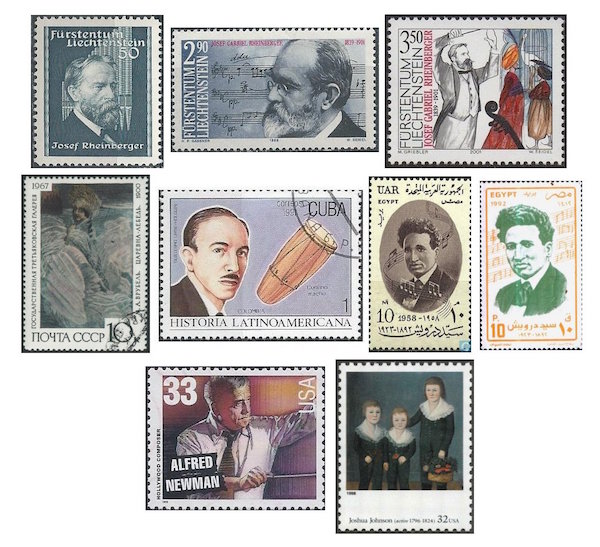The Arts on the Stamps of the World — March 17
An Arts Fuse regular feature: the arts on stamps of the world.

By Doug Brisco
King for the Day is Nathaniel Adams Coles, but we’ll also pay tribute to one architect (from the thirteenth century!), an auto designer, two painters, and four other music people.
Even as a kid I thought one of the most delectable voices in all music was that of the great Nat King Cole (March 17, 1919 – February 15, 1965). He was born in Montgomery, Alabama and grew up from the age of four in North Chicago. His mother was a church organist, and Nat learned to play from her, with formal lessons beginning when he was 12. Most casual listeners probably don’t know that he began his career as a jazz pianist and only became a singer more or less by happenstance. Apparently the “King” simply comes from association with “Old King Cole”.
One of the first medieval French architects known by name was Pierre de Montreuil, who was for a time erroneously referred to as Pierre de Montereau because of a misreading of a tombstone inscription. A number of buildings have been attributed to him, but only one, or rather, parts of one, with certainty: the rectory (long since destroyed) and fragmentary Chapel of the Virgin for the abbey of Saint-Germain-des-Prés in Paris. The stamp honors the abbey and not the architect, but it’s as close as I could come. Pierre’s birthday is unknown; he died on 17 March 1267.
American portrait painter Charles Peale Polk (March 17, 1767 – May 6, 1822) was the nephew of Charles Willson Peale, whose birthday is coming up in a month. The older man’s paintings served as a model for Polk’s earliest work—he made copies of Peale’s paintings just as he would later do for his own. It is said the he made no fewer than 57 copies of the portrait of George Washington we see on this 1934 US stamp, which comes from the same Washington centenary set we drew upon when we commemorated the birthday of Charles de Saint-Mémin just five days ago. For a long time it was thought that Polk must have had some contact with the mixed-race artist Joshua Johnson (see below), given the similarities of their work, but now research has shown that there was no connection between the men.
Gottlieb Daimler (1834 – 6 March 1900) was an engineer and inventor, not a designer of automobile bodies, but I thought we’d include a few stamps showing his original 1886 machine, a later model of 1899 (the San Marino stamp), and the gorgeous Austro-Daimler ADR 22/70 from, I think, 1929.

Josef Rheinberger (1839 – 25 November 1901) was born in the capital of Liechtenstein, Vaduz. At the age of seven, he was already playing organ at the Vaduz parish church. He attended the Munich Conservatory, where upon graduation he taught piano and composition, and lived most of his life in Germany. He was named court conductor in 1877, his duties including composition of music for the royal chapel (he wrote twelve masses, a lovely Christmas cantata, and many works for the organ). As a teacher, he had many distinguished students, George Whitefield Chadwick, Wilhelm Furtwängler, Horatio Parker, and Ermanno Wolf-Ferrari among them. Liechstenstein has proudly issued three postage stamp designs in honor of her native son.
The very distinctive style of Mikhail Vrubel (1856 – April 14, 1910) sets him apart from his Russian Symbolist and Art Nouveau contemporaries, as he adopted elements from Late Byzantine and Early Renaissance painting into his work. His also mixed bronze chips into his paint, which gave them a striking luster but which over time has unfortunately deteriorated. Born in Omsk to a father in the miltary and a Danish mother who died when he was three, Vrubel enjoyed that rarity among artists: the encouragement of his father in his pursuit of the arts. (Vrubel did obtain a law degree from St Petersburg University in 1880.) After study under Pavel Chistyakov at the Imperial Academy of Arts, he was commissioned to prepare new murals for the Church of St. Cyril in Kiev and went to Venice to learn about early Christian art, but his proposals were rejected for their, you should pardon the expression, unorthodoxy. It was about this time that Vrubel began his series of works inspired by the character of the demon in Lermontov’s poem of that name. Later, in Moscow, Vrubel worked in ceramics, majolica, and stained glass as well as in stage sets and costumes. His painting The Swan Princess (1900), seen on this USSR stamp of 1967, was an offshoot of the theatrical work he did for his wife, the soprano Nadezhda Zabela, who sang the role in the Rimsky-Korsakov opera The Tale of Tsar Sultan and was the model for this picture. Alas, Vrubel suffered a mental breakdown and increasing blindness from syphilis and was unable to paint after 1906.
Guillermo Uribe Holguín (17 March 1880 – 26 June 1971) was born in the capital of Colombia, Bogotá. At the Schola Cantorum in Paris his fellow students under Vincent d’Indy included Erik Satie and Joaquín Turina. Uribe furthered his violin studies in Brussels. Back in Colombia in 1910, he became director of the National Conservatory of Music, where he put together an orchestra that developed into what today is the National Symphony Orchestra of Colombia. A strikingly prolific composer, Uribe wrote about a dozen symphonies (one source lists 11, another says 13), an opera and a ballet, a requiem (for his wife, who died young), four concertos (two for violin), ten string quartets, seven violin sonatas, and a series of 300 Trozos en el sentimento popular (pieces in the popular style, based on folk dances) for piano. The stamp, as you may have noticed, comes not from Colombia but rather from a set of Cuban stamps commemorating Latin-American composers of various countries.
Sayed Darwish (1892 – 15 September 1923) is less known in the West than he might have been, given his grounding in 19th century European music, but he modified his singing and many compositions (his own and others) to suit the tastes of an Egyptian audience, and he is admired today for his work in the popular music of that country. He wrote some 260 songs as well as works in the Arabic tradition. One of the songs, “Bilaadi! Bilaadi!” (“My Country! My Country!”), was adopted as Egypt’s national anthem. On the classical (or light-classical) side he composed 26 operettas and began work on an opera, Cleopatra and Mark Anthony.

Alfred Newman (1900 – February 17, 1970), born in New Haven, was the eldest of ten children. He performed in vaudeville as “The Marvelous Boy Pianist” before moving on to Broadway and then Hollywood, at first as a conductor. Over the next forty years he produced two hundred film scores, nine of them awarded Oscars. His first Oscar was for John Ford’s 1937 movie The Hurricane. Some of the other famous films for which Newman wrote the scores are Gunga Din, Wuthering Heights, The Hunchback of Notre Dame (all in 1939), The Mark of Zorro (1940), How Green Was My Valley (1941), The Song of Bernadette (1943), Gentleman’s Agreement (1947), Twelve O’Clock High (1949), All About Eve (1950), The Diary of Anne Frank (1959), How the West Was Won (1964), and two versions of The Prisoner of Zenda (1937 and 1952). His last score was for Airport in 1970. Newman’s brother Lionel and his sons David and Thomas have among them written a further 200 film scores. Another brother, Emil, was music director for some eighty films; his daughter Maria is a violinist and composer of concert music who has also made a specialty of writing new scores for restored silent films; his nephew is Randy Newman; and the tradition continues into a third generation with the work of his grand-nephew Joey, who, in addition to his original music for TV and video, orchestrated the scores for Seabiscuit (2003) and Cars (2006).
It was on this day in 1941 that the National Gallery of Art in Washington, D.C. was officially opened by President Franklin D. Roosevelt. One way for me to sneak in the work of artists whose dates of birth and death are unknown is to show it relative to its housing. This portrait of The Westwood Children was executed by Joshua Johnson (c.1763 – c.1824), believed to be the first person of color to be able to earn his living by painting in the United States. It seems Johnson was the son of a white man named George Johnson (or Johnston) and a slave woman, and that George Johnson purchased his son’s freedom from the slave owner. The mother, it seems, did not receive the same boon. We don’t even know her name. Johnson was active in Baltimore and was commissioned to create paintings for numerous prominent Maryland families.
A graduate of the University of Massachusetts with a B.A. in English, Doug Briscoe worked in Boston classical music radio, at WCRB, WGBH, and WBUR, for about 25 years, beginning in 1977. He has the curious distinction of having succeeded Robert J. Lurtsema twice, first as host of WGBH’s weekday morning classical music program in 1993, then as host of the weekend program when Robert J.’s health failed in 2000. Doug also wrote liner notes for several of the late Gunther Schuller’s GM Recordings releases as well as program notes for the Boston Classical Orchestra. For the past few years he’s been posting a Facebook “blog” of classical music on stamps of the world, which has now been expanded to encompass all the arts for The Arts Fuse.
